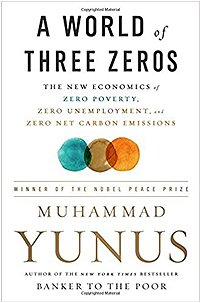Microfinance's Success Sets Off a Debate in Mexico
New York TimesMexico
Carlos Danel and Carlos Labarthe turned a nonprofit that lent money to Mexico's poor into one of the country's most profitable banks.
But not all of their colleagues in the world of microlending — so named for the tiny loans it grants — are heaping praise on the co-executives of Compartamos. Some are vilifying them as "pawnbrokers" and "money lenders."
They are the center of a fractious debate: how far should microfinance go toward becoming big business?
At one end stand traditional microlenders, like the economist Muhammad Yunus, founder of the most famous microlender, the Grameen Bank, and winner of the 2006 Nobel Peace Prize. At the other are the Two Carloses, as they are widely known in this tight-knit world that gave them their start as starry-eyed idealists.
Microlenders, the original and still the most common type of microfinance organization, help the poor start or expand businesses in places most banks shun, like the slums of Calcutta or these impoverished hills in Mexico's sugar cane country, three hours south of Mexico City. Their efforts are widely considered successful in transforming the lives of developing-world entrepreneurs, particularly women, and their families.Many microlending advocates, including Mr. Yunus, say that success is threatened by Mr. Danel and Mr. Labarthe's market-oriented model, with its emphasis on investor returns.
"Microfinance started in the 1970s with a focus on using this breakthrough to help end poverty," said Sam Daley-Harris, director of the Microcredit Summit Campaign, a nonprofit endeavor that promotes microfinance for families earning less than $1 a day. "Now it is in great danger of being how well the investors and the microfinance institutions are doing and not about ending poverty." He said the situation posed the danger of "mission drift."
Mr. Danel and Mr. Labarthe say microfinance will help more poor people by tapping the boundless pool of investor capital rather than the limited pool of donor money.
"It's marvelous to have one creditor but it's marvelous to have one million creditors," Mr. Labarthe said, "and that's where we really start to change the face of opportunity."
Compartamos ("let's share" in Spanish) expects to reach one million borrowers this year. Its profits are healthy, some $80 million last year, and its portfolio has grown to almost $400 million. Since it went public nearly a year ago, return on equity has been more than 40 percent.
Both sides agree that there is a need for capital, too great to be met by the donor groups that initially financed microlending. Deutsche Bank estimates the global demand for microfinance loans at about $250 billion, 10 times the amount that has been lent.
But Compartamos's decision to go public last April became a flashpoint in what had been a genteel debate over how microfinance could tap into the financial markets' vast resources. The initial public offering gets special mention at every microfinance conference, and has been condemned by Mr. Yunus, the Nobel laureate.
Alex Counts, president of the Washington-based Grameen Foundation, said Compartamos's poor clients "were generating the profits but they were excluded from them."
Lynne Patterson, a founder of Pro Mujer, a nonprofit microfinance group with branches in several Latin American countries, agrees. "We use the profit to reinvest in the service of the clients," she said, referring to loan repayment profits.
Since lack of access to credit is just one of the problems the poor face, Pro Mujer also offers services like breast cancer screenings, advice on dealing with domestic violence and financial education.
Still, in three decades microfinance has evolved — from small nongovernmental organizations lending $50 to women to buy sewing machines or fruit to sell at market to, in some cases, formal banks that cover costs and grow through profits, like any business.
On Wall Street, investment banks package microfinance loans to sell to institutional investors, many of them "socially responsible" and looking for steady returns rather than trading profits. A few equity funds have even taken stakes in microfinance institutions.
Critics say that Compartamos manages its business to benefit its investors, not its borrowers. The bank began as a nongovernmental organization in 1990, started by a Catholic social action group called Gente Nueva, whose inspiration was a visit by Mother Teresa to Mexico.
After Compartamos became a for-profit company in 2000, costs fell as efficiencies increased, but the bank kept interest rates high. On average, customers pay an annual interest rate of almost 90 percent, which includes 15 percent in government tax. In much of the world, microfinance interest rates range from 25 to 45 percent. But in Mexico, high costs, inefficiency and limited competition keep interest rates much higher. Compartamos's rates are only a few percentage points higher than Pro Mujer's, for example.
Like microfinance businesses around the world, Compartamos makes loans without collateral. Its borrowers, who are nearly all women, are organized in groups, which guarantee the loans. Stop paying and your friends must pay for you: the system keeps default rates down.
Historically, microlenders point out, such borrowers are excellent risks. For instance, Compartamos's nonperforming loans were just 1.36 percent of its portfolio at the end of last year.
Servicing those loans takes labor and that pushes up rates on such small amounts. A Compartamos collection agent visits each group every week, riding public buses out to villages.
Compartamos is more efficient than other Mexican microfinance institutions and its own borrowing costs are lower, thanks to its strong credit rating. Critics charge that it has not passed those savings on to its customers.
The numbers seem to bear that out. A study last year by the Consultative Group to Assist the Poor, known as CGAP, a microfinance industry group based at the World Bank, estimated that 23.6 percent of Compartamos's interest income went to profits. Its return on average equity is more than triple the 15 percent average for Mexican commercial banks.
Profit is not a dirty word in the microfinance world. The question is how much is appropriate. CGAP estimates the average return on assets for self-sufficient organizations to be 5.5 percent. The figure for Compartamos was 19.6 percent in the fourth quarter.
Mr. Danel said Compartamos's interest rates have fallen 30 percentage points over the last five years. "They go down based on efficiencies, and we pass this benefit on to the customer," he said.
Compartamos grew to 840,000 customers last year, from 60,000 in 2000.
Last April, Compartamos' owners sold 30 percent of their stock on the Mexican stock market in an initial public offering. The public offering brought in $458 million. Private Mexican investors, including the bank's top executives, pocketed $150 million from the sale. More than half of the public offering proceeds went back to development institutions that had invested in Compartamos when it moved from being a nonprofit to a commercial venture in 2000.
One of them was Acción International, a Boston-based nongovernmental organization that helps build microcredit institutions and provides them with technical assistance. Acción invested $1 million in Compartamos in 2000. It sold half its 18 percent stake at the time of the public offering for $135 million.
"This is one strategy to address poverty that doesn't remain small and beautiful," said MarÃa Otero, president of Acción.
Charles Waterfield, a microfinance consultant who has been among the most vocal critics of Compartamos's model, disagrees. "Not only are they making obscene profits off poor people, they are in danger of tarnishing the rest of the industry," he said. "Compartamos is the first but they won't be the last."
There has not been a rush to market yet. In part, the subprime mortgage debacle and the ensuing selloff on global markets has made this a poor time for initial public offerings. Compartamos has not escaped the turmoil; its stock price is up nearly 17 percent since the offering, but down 32 percent from its high last July.
Those who argue for more such public offerings say that Compartamos set the right example.
"Boy, you got a lot of people's attention with that I.P.O.," said Bob Pattillo, who runs Gray Ghost, a fund that invests in microfinance. "This has got Wall Street's eye, London's eye, Geneva's eye — to have one out there to say that if all the dots got connected this can be quite profitable."
Mr. Danel and Mr. Labarthe argue that successful microlenders in a middle-income country like Mexico should use the capital markets, instead of crowding out donations.
As part of their defense, they argue that Compartamos's success has prompted a number of institutions, including traditional banks and retailers, to start offering financial products to the poor. "We don't only see ourselves as a specialist in microfinance but also as the builder of an industry," Mr. Danel said.
Compartamos estimates that its target market is 14 million households, more than half of the country's population, most of them with little or no access to banking services.
At the recent weekly meeting of a group of Compartamos borrowers in the village of Valle de Vázquez, the interest rate was not a great concern. Indeed, several women said they had left another microfinance institution because it charged more.
The group was well established, 35 strong and well into its third year of borrowing. The meeting, which took place in the living room of one borrower's home, was the start of a new four-month borrowing cycle.
A Compartamos manager, Claudia Ayala, began with a pep talk, pointing to a house plant set on a chair beside her. "This plant grows and this group can grow," she said to the women, who were listless in the afternoon heat. "How? By inviting more compañeras," or friends. "By fertilizing it with responsibility," she said.
Though the village depends largely on remittances sent by relatives in the United States, the Compartamos loans have helped some women become self-sufficient.
Silvina MartÃnez started a little restaurant in her house a year ago to sell her homemade snacks to students at a nearby high school. It has grown steadily since then. With this cycle, she was going to borrow about $1,100 to paint the restaurant and expand her menu. "It's my own business," she said. "You are a slave to it, but at least it's mine."
Other women were successful entrepreneurs to start with, but the Compartamos credit gives them a push, allowing them to hire an employee or help ease their cash flow.
Alejandra Abúndez, 57, keeps pigs and cattle, and produces 330 pounds of cheese a day, which she sells in the local market. She and her daughter, Micaela Rivera, were borrowing $3,550 from Compartamos to buy animal feed and to stock the tiny store in her front entryway.
"Everything I have, I invest," said Ms. Abúndez, who was left a widow with five children at 35. "No gadding about for me."


